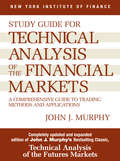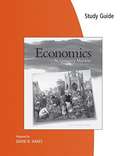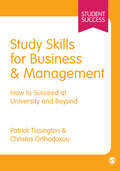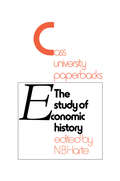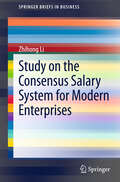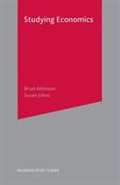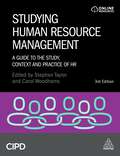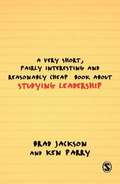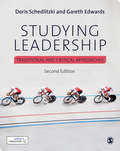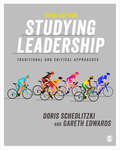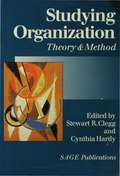- Table View
- List View
Study Guide to Technical Analysis of the Financial Markets
by John J. MurphyThis outstanding reference has already taught thousands of traders the concepts of technical analysis and their application in the futures and stock markets. Covering the latest developments in computer technology, technical tools, and indicators, the second edition features new material on candlestick charting, intermarket relationships, stocks and stock rotations, plus state-of-the-art examples and figures. From how to read charts to understanding indicators and the crucial role technical analysis plays in investing, readers gain a thorough and accessible overview of the field of technical analysis, with a special emphasis on futures markets. Revised and expanded for the demands of today's financial world, this book is essential reading for anyone interested in tracking and analyzing market behavior.
Study Guide: Mankiw's Principles of Economics (5th Edition)
by N. Gregory MankiwDavid R. Hakes (University of Northern Iowa) has prepared a study guide that will enhance student success. Each chapter of the study guide includes learning objectives, a description of the chapter's context and purpose, a chapter review, key terms and definitions, advanced critical thinking questions, and helpful hints for understanding difficult concepts. Students can develop their understanding of the material by doing the practice problems and answering the short-answer questions, then assess their mastery of the key concepts with the self-test, which includes true/false and multiple-choice questions.
Study Skills for Business and Management: How to Succeed at University and Beyond (Student Success)
by Patrick Tissington Christos OrthodoxouWant to stand out from the thousands of other business and management students when you graduate from university? This comprehensive study skills book gives you all the tools and techniques needed to graduate with a better degree than you thought possible. Study Skills for Business and Management is written in an entertaining and non-patronising way and is filled with examples and case studies. With chapters on efficient and effective reading, working in groups, managing and writing essays and succeeding in exams, this textbook is written specifically with business and management students′ needs in mind. Key features: Written by an academic and a recent business and management graduate who are in touch with what it is like to study Business and Management today and the challenges students face Based on primary research in to which study skills are the most effective, providing an evidence-based approach that you can trust in and saving you precious time Contains a wealth of current examples from recent business and management graduates, highlighting examples of good practice as well as common pitfalls to avoid Student Success is a series of essential guides for students of all levels. From how to think critically and write great essays to boosting your employability and managing your wellbeing, the Student Success series helps you study smarter and get the best from your time at university.
Study Skills for Sports Studies
by Tara MagdalinskiStarting university can be a daunting prospect, as students come to grips with new ways of working, learning and thinking. Studying sport at university poses particular challenges, with students often engaged in playing or coaching sport alongside their studies and having unconventional working patterns. Study Skills for Sport Studies is the only complete guide to degree-level study to be written specifically for students on sport-related courses, outlining the core academic competencies needed to succeed at university. The textbook offers tips and techniques for all aspects of higher education, including time management, critical thinking, academic research and writing, e-learning, presentations, group work and exams. The practical processes are supported by sports-related examples, and each chapter ends with useful exercises to test your skills as well as reflect on your prior learning experiences. Designed as either a self-paced text or a companion to an introductory class, Study Skills for Sports Studies demystifies the academic skills needed to succeed and helps you make the most of your time at university.
Study Your Way to Your Perfect Career: How to Become a Successful Student, Fast, and Then Make it Count (Student Success)
by Lucinda BeckerNew to university and not sure what you should be doing, or when? This book shows you how to make university work for you. Taking into account academic, personal, and practical experiences, it helps you make the most of all the opportunities your course has to offer: Offers savvy insider hints to help you prepare yourself for university ‘firsts’, like tutorials, lectures, group projects and dissertations Encourages you to think about how your achievements and experiences help you curate the skills and qualities future employers want to see Demonstrates how making the right choices at university can be a springboard into professional and personal development. With a confidence-building tone, helpful tips and a host of relatable examples, this book doesn't just help you get started at university - it helps you make it count. The Student Success series are essential guides for students of all levels. From how to think critically and write great essays to planning your dream career, the Student Success series helps you study smarter and get the best from your time at university. Visit the SAGE Study Skills hub for tips and resources for study success!
Study Your Way to Your Perfect Career: How to Become a Successful Student, Fast, and Then Make it Count (Student Success)
by Lucinda BeckerNew to university and not sure what you should be doing, or when? This book shows you how to make university work for you. Taking into account academic, personal, and practical experiences, it helps you make the most of all the opportunities your course has to offer: Offers savvy insider hints to help you prepare yourself for university ‘firsts’, like tutorials, lectures, group projects and dissertations Encourages you to think about how your achievements and experiences help you curate the skills and qualities future employers want to see Demonstrates how making the right choices at university can be a springboard into professional and personal development. With a confidence-building tone, helpful tips and a host of relatable examples, this book doesn't just help you get started at university - it helps you make it count. The Student Success series are essential guides for students of all levels. From how to think critically and write great essays to planning your dream career, the Student Success series helps you study smarter and get the best from your time at university. Visit the SAGE Study Skills hub for tips and resources for study success!
Study of Economic History: Collected Inaugural Lectures 1893-1970
by N. B. HartePublished in the year 1975, Study of Economic History is a valuable contribution to the field of Military and Strategic Studies.
Study on China’s Industrial Competitiveness
by Yanyun ZhaoThis book builds an information platform on China's industrial competitiveness, providing scientific design and application case studies for integrated analysis and decision-making facilities and mechanisms for enterprises, industries, financial institutions and governments, which can make up for the lack of adequate information in China's market operations, especially the problems of duplicate construction and vicious competition aggravated by the lack of systematically processed industrial information. This book not only pursues innovation in technical methods and application theories but also pursues the collection, processing and collation of relevant domestic and international data and development and application so as to provide primary results for an industrial competitiveness database adapted to government management needs. The research is closely related to the actual problems in China and extensively uses statistical data to make various model analyses, which has a relatively sizeable academic value.
Study on Quality of Life of Chinese Residents with Social Change
by Peigang WangThis book makes a systematic empirical analysis of the quality of life of Chinese residents from the perspective of social change, expounds the connotation, theory, elements, and research methodology of the quality of life, and focuses on the diachronic dynamic analysis of the multidimensional elements of the quality of life from the perspective of life course and life cycle. According to the research content, the book is divided into three topics. The first topic, from the first chapter to the third chapter, mainly focuses on the quality of life research and theoretical evolution, providing theoretical guidance for the empirical analysis of the book and scientific significance for the study of the quality of life in social change. The second project, from Chapter 4 to Chapter 7, focuses on the influence factors of quality of life of a Chinese resident, structure composition, and the relationship between the related factors to conduct empirical research, the purpose is to more clearly understand the present status of life quality in the Chinese culture, for the further scientific research was related to quality of life to provide the basic framework. The third topic, from Chapter 8 to Chapter 13, focuses on empirical analysis of the changes and development of subjective and objective quality of life of Chinese residents.
Study on the Auditing System of Socialism with Chinese Characteristics
by Jiayi LiuA comprehensive, authoritative examination of Chinese auditing practices Study on the Auditing System of Socialism with Chinese Characteristics provides unprecedented insight into China's current audit process, with expert contributions and predictions of future trends. Author Jiayi Liu is the Auditor General of the National Audit Office of the People's Republic of China, and the current chairman of the governing boards of the International Organizations of Supreme Audit Institutions; in this book, he draws upon his vast experience to help you better understand China's unique approach to auditing. Contributions from senior auditors across the China National Audit Office share deep insight into the system's framework, features, and development, providing a comprehensive, systematic examination of current, past, and future practices. As a leading global auditing authority, Liu is the ideal source of information and clarity on China's auditing system. This book opens up the practices, processes, and foundational aspects of this complex system to provide insight for those doing business in China. Understand the foundation of the Chinese auditing system Learn how the system was created and developed over time Delve into the system's framework and detailed features Gain first-hand insight into China's auditing experience Developed as a companion to Study on the Auditing Theory of Socialism with Chinese Characteristics, this book expands upon the system's basic foundations to show how theory translates into practice. Companies who do business in China need a working knowledge of the system, and a scientific examination from the definitive authority provides a level of insight you won't find anywhere else. Study on the Auditing System of Socialism with Chinese Characteristics is the essential primer to the Chinese audit.
Study on the Auditing Theory of Socialism with Chinese Characteristics, Revised Edition
by Jiayi LiuA comprehensive guide to China's public, private, and internal audit system Study on the Auditing Theory of Socialism with Chinese Characteristics provides a comprehensive overview of China's auditing practices. Recent years have seen the National Audit Office of China (CNAO) making remarkable headway not only in China by guaranteeing the healthy operation of the economy and society and improving national governance through government auditing, but also in the international arena by carrying out audits with the United Nations. With constant development in the practice, an audit theory with socialist Chinese characteristics has taken shape, centering on the premise that government auditing serves as the cornerstone and safeguard of national governance. At the XXI INCOSAI held in 2013 in Beijing, the theme of "national audit and national governance" proposed and chaired by CNAO, was met with widespread approval by participants from over 160 countries, and led to the endorsement of the Beijing Declaration, which makes it a priority and target for audit institutions to promote good national governance. To explore the nature and development of government auditing, this book probes into the history and reality, and theories and practices of auditing in various countries, and puts forward the assertion that, "as a cornerstone and important safeguard for national governance, government auditing is an 'immune system' endogenous within the synthetical system of national governance, with functions of precaution, revelation and defense." Furthermore, China's socialist auditing theory has been elaborated in nine aspects, nature, functions, goals, features, methods, management, framework of regulations and standards, IT application and culture, covering the new concepts, methodologies, techniques and achievements of China's government auditing. This book is highly relevant, practical, and readable. Jiayi Liu, the chief author, is the Auditor General of China and the current Chairman of INTOSAI Governing Board. In 2013 he won the United Nations Peace Prize in recognition of his auditing work for UN peacekeeping operations.
Study on the Consensus Salary System for Modern Enterprises
by Zhihong LiFor firms, the salary issue is extremely important for their business operations and development. In order to investigate this issue and to expand the role of the salary system in business management, the book presents the Consensus Salary Model for modern enterprises and further explores its theoretical foundations, decisive mechanisms and features, and provides a basic framework for designing salary systems for modern enterprises. Finally, the book incorporates empirical research to test the model.
Study on the National Conditions of Modernization with Chinese Characteristics (Understanding Xi Jinping’s Governance)
by Angang Hu Shaojie Zhou Yize XieThis is an open access book. Based on the analysis of China’s basic national conditions and development trends, this book begins with a general introduction to the study of “modernization with Chinese characteristics,” and then discusses the comprehensive construction of a prosperous society in all respects, unprecedented changes, the new national system, green modernization, and technological modernization. In addition, there will be a presentation of in-depth research on topics such as leapfrog development of human capital market, the new stage of socialism, common prosperity in 2035 and a summary of the basic characteristics and great significance of modernization of a Chinese-style economy, technology, and education. Through historical comparison, this work will show the development, stages and future prospects of modernization with Chinese characteristics -- focusing on international comparison, especially a quantitative comparison with Western countries. This will further highlight the fast-paced effect of modernization with Chinese characteristics, and place emphasis on the uniqueness and innovativeness of modernization with Chinese characteristics.
Studying Business at University: The Survival Guide
by Andreas GiazitzogluTaking a business degree at university – whether it is in management, marketing, operations management, finance, accounting, economics or another subject – is a fulfilling and rewarding experience. But how can you know, before you choose your subject, what it will be like? How is it possible to make an informed decision?Look no further. Studying Business at University provides new and prospective undergraduates with a concise and easy-to-read insight into what life is like as a business student today. This student-friendly book, written in the style of an email dialogue between two students, informs and reassures the new business student who is seeking advice on how to get the most out of their degree experience and covers the whole degree from application to graduation – and beyond. Covering questions of employability, work placements, job interviews and emerging concerns such as the use of Artificial Intelligence (AI) in research and essays, this book is an up-to-date window on the modern student experience.Ideal for final-year college students who are choosing their degree subject as well as undergraduates and international students who are actively navigating their way through their business degree course, this book will also be a helpful reference for lecturers who want to give their students as much support as possible as they learn to balance the demands of academia with the pressures of the real world.
Studying Economics
by Brian Atkinson Susan JohnsStudying Economics provides a thorough, yet digestible and friendly introduction to this often daunting subject. The complex components of economic theory and practice are broken down and explained using a logical approach, supported by working examples, tables and graphs. Introducing differing mainstream approaches to economic study, from Marxian to feminist to environmental, this book puts Economics into a context which is easy for any student to understand. Explaining why and how we should study Economics, the book contains invaluable information on course content, learning techniques, revision, writing essays and dissertations, and examination assessment.
Studying Human Resource Management: A Guide to the Study, Context and Practice of HR
by Stephen Taylor Carol WoodhamsStudying Human Resource Management is an ideal textbook for anyone studying the CIPD Level 5 Associate Diploma in People Management. Fully updated throughout, this book provides thorough coverage of the study of HRM, managing and co-ordinating the HR function, organisational performance and culture in practice as well as business issues in the context of HR. Written by experts in the field with both academic and practitioner experience, Studying Human Resource Management includes invaluable discussion on professional behaviours for people professionals and guidance on how to manage HR data and information and most importantly, how to use it to make evidence-based decisions. There are also now two brand new chapters on diversity and inclusion (D&I) and wellbeing at work. Each chapter includes key learning outcomes to summarise the content that will be covered and to help students track their progress, reflective activities to consolidate learning and further reading suggestions to support wider engagement with areas of particular interest. This book also includes case studies to help students understand how the theory applies in practice. Online resources include Powerpoint slides, a lecturer guide and annotated web links.
Studying Leadership
by Brad Jackson Ken ParryIn this portable (5x8") supplementary text designed for advanced students, the authors "have tried to make up for the lack of visual content with our lucid prose and biting wit. " Using plain language and a minimum of academic terminology, Jackson (chair, leadership department, U. of Auckland Business School, Australia) and Parry (director, the Center for Leadership Studies, Bond U. ) emphasize the interdisciplinary and applied nature of leadership, and integrate material on doing, observing, talking, reading, and writing about leadership. A unique feature of the text is its balanced coverage of both leader-centered and follower-centered perspectives, as well as cultural and cross-cultural perspectives. Later chapters present the work of researchers who argue that conventional leadership studies tend to reinforce the status quo, and look at attempts to rehabilitate leadership in response to corporate scandals and financial crises. An appendix offers lists of popular and reference books, journals, associations, research centers, and Hollywood films that deal with leadership. Annotation ©2011 Book News, Inc. , Portland, OR (booknews. com)
Studying Leadership: Traditional and Critical Approaches
by Doris Schedlitzki Gareth EdwardsThis innovative new text will guide students of leadership through the past, current and future of the discipline. It goes beyond the standard topics covered in existing texts to introduce some exciting new themes such as authenticity, toxicity, followership, gender, diversity, arts, aesthetics, language, identity, ethics and sustainability. This makes for a fascinating read, and allows for a more holistic and deeper understanding of the field. <P><P> A range of in-text features have been developed to enhance your learning experience including boxes highlighting key debates and encouraging critical analysis, 6 long integrative case studies and numerous vignettes to help you apply theory to practice, over 140 reflective questions to test your understanding as well as further reading lists.<P> Visit the book's website www.sagepub.co.uk/studyleadership to access to related SAGE journal articles, video links and more.
Studying Leadership: Traditional and Critical Approaches
by Doris Schedlitzki Gareth EdwardsNow in its Second Edition, Studying Leadership continues to provide a comprehensive overview of the key theories, topics, research debates and major developments in the field of leadership studies. Split into three parts, the book covers the traditional and mainstream theories on leadership; the main topics and perspectives explored in leadership research, and the recent trends in leadership studies such as gender and diversity, ethics, sustainability, language and identity. The new edition features a chapter on “Researching Leadership” and includes extended case studies to enhance learning and support students with their dissertations and research projects. The book is complemented by a companion website featuring a range of tools and resources for lecturers and students, including chapter specific multiple-choice questions, case studies, videos with critical thinking questions and discussion questions, free SAGE journal articles, PowerPoint slides and an instructor’s manual. Suitable reading for students on leadership courses across a range of subjects including Business & Management, Health and Education.
Studying Leadership: Traditional and Critical Approaches
by Doris Schedlitzki Gareth EdwardsNow in its Second Edition, Studying Leadership continues to provide a comprehensive overview of the key theories, topics, research debates and major developments in the field of leadership studies. Split into three parts, the book covers the traditional and mainstream theories on leadership; the main topics and perspectives explored in leadership research, and the recent trends in leadership studies such as gender and diversity, ethics, sustainability, language and identity. The new edition features a chapter on “Researching Leadership” and includes extended case studies to enhance learning and support students with their dissertations and research projects. The book is complemented by a companion website featuring a range of tools and resources for lecturers and students, including chapter specific multiple-choice questions, case studies, videos with critical thinking questions and discussion questions, free SAGE journal articles, PowerPoint slides and an instructor’s manual. Suitable reading for students on leadership courses across a range of subjects including Business & Management, Health and Education.
Studying Leadership: Traditional and Critical Approaches
by Doris Schedlitzki Gareth EdwardsThis book is your comprehensive guide to key leadership theories, topics and trends. It goes beyond the basics to explore contemporary issues such as power and politics, authenticity, followership, toxicity, language, identity, ethics and sustainability, enabling you to gain a deep, holistic understanding of the field. Updated throughout with new examples, Critical Thinking boxes and further reading suggestions, the third edition of Studying Leadership: Traditional and Critical Approaches is the ideal accompaniment to leadership courses across a range of subject areas, including Business & Management, Health and Education. Lecturers can access a range of useful resources, including an instructor’s manual, selected SAGE Business Cases and videos, PowerPoint slides and a testbank, via the companion website. Doris Schedlitzki is Professor in Organisational Leadership at Guildhall School of Business and Law, London Metropolitan University. Gareth Edwards is Professor of Leadership and Community Studies at Bristol Business School, University of the West of England.
Studying Leadership: Traditional and Critical Approaches
by Doris Schedlitzki Gareth EdwardsThis book is your comprehensive guide to key leadership theories, topics and trends. It goes beyond the basics to explore contemporary issues such as power and politics, authenticity, followership, toxicity, language, identity, ethics and sustainability, enabling you to gain a deep, holistic understanding of the field. Updated throughout with new examples, Critical Thinking boxes and further reading suggestions, the third edition of Studying Leadership: Traditional and Critical Approaches is the ideal accompaniment to leadership courses across a range of subject areas, including Business & Management, Health and Education. Lecturers can access a range of useful resources, including an instructor’s manual, selected SAGE Business Cases and videos, PowerPoint slides and a testbank, via the companion website. Doris Schedlitzki is Professor in Organisational Leadership at Guildhall School of Business and Law, London Metropolitan University. Gareth Edwards is Professor of Leadership and Community Studies at Bristol Business School, University of the West of England.
Studying Management Critically
by Mats Alvesson Hugh Willmott`An excellent source for graduate students, especially in the field of human resource development, who are exploring areas for future research of a critical nature' - Adult Education Quarterly Drawing upon a range of influential contemporary movements in the social sciences, primarily upon critical traditions, such as the Critical Theory of the Frankfurt School, this text provides a wide ranging analysis of management and its various specialisms. The book offers critical understandings of key areas of management theory and practice such as accounting, strategic management, marketing, business ethics and environmental management. It also examines the relations between power and discursive practices in the modern corporation; the role of architecture as a repressive and emancipatory force in organizations; gender and organizations and critical methodology for organizational research. Key issues of power/knowledge relations across these areas are addressed and new agendas both for these fields and for management studies as a whole are introduced. Contributing authors include: Mats Alvesson, Gibson Burrell, David Cooper, Karen Dale, Stan Deetz, Linda Forbes, John Forester, John Jermier, David Levy, Joanne Martin, Glenn Morgan, Martin Parker, Mike Power, Richard Loughlin and Hugh Willmott
Studying Organization: Theory and Method (Routledge Studies in Management, Organizations and Society #Vol. 3)
by Stewart R Clegg Cynthia HardyIn response to the needs of lecturers, the acclaimed Handbook of Organization Studies has been made available as two major paperback textbooks. In this, the first of a two-volume paperback edition of the landmark Handbook of Organization Studies, editors Stewart Clegg and Cynthia Hardy survey the field of organization studies. Studying Organization is an ideal textbook around which to build courses on organization theory and research methodology. Central to the enterprise has been a concern to reflect and honour the manifest diversity of the field, including recognition of the extent to which the very notion of a single field of organization studies is debated. Part One locates the study of organization by reviewing some of the most significant theoretical paradigms to have shaped our understanding. The second part reflects on the relationships between theory and research in organization studies.
Studying Political Parties as Organizations: Four Perspectives on Denmark’s Alternative Party (Organizations and Activism)
by Emil HustedThis book outlines what it means to study political parties as organizations by developing and applying four theoretical perspectives to the case of an unconventional Green party in Denmark called Alternativet (meaning ‘the alternative’). Drawing on an ethnographic study, the book tracks the party’s humble origins in 2013 as a social movement through its inaugural term until the 2022 national elections, spotlighting Alternativet's unprecedented organizational dynamics. By dissecting this ‘party that did not want to be a party’ through classical, configurational, comparative, and cultural lenses, the author opens a new area of enquiry to scholars in organization and management studies.
